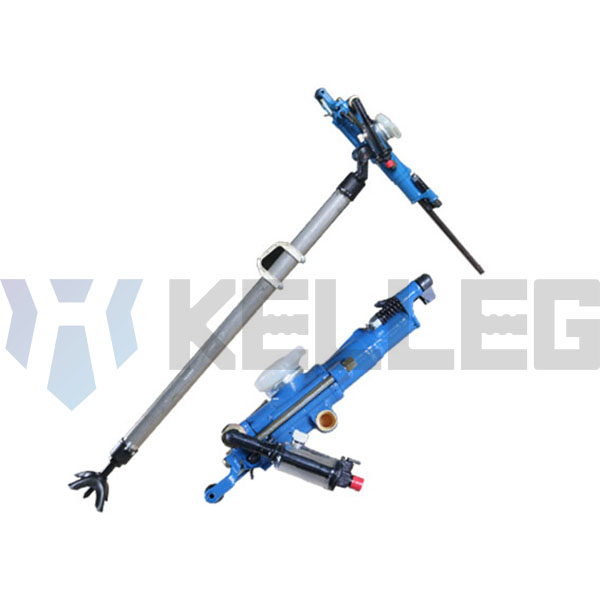2020 官网升级中!现在您访问官网的浏览器设备分辨率宽度低于1280px请使用高分辨率宽度访问。
In the 21st century, the world economy is developing rapidly and science strength continues to strengthen. It has directly promoted the rapid development of railways, highways, hydropower, and other industries. With the development of these industries, the amount of geotechnical engineering during construction began to increase, which promoted the development of rock drilling equipment. For example, when people face a project with a large amount of rock drilling, they generally use the drill and blast method. At this time, the use of efficient and economical rock drilling equipment will greatly improve people’s work efficiency, and hydraulic rock drills are one of the best choices. Since the hydraulic rock drill is a relatively new type of rock drill, many people do not know it, so today we will share with you what hydraulic drill is.
What is a hydraulic rock drill?

A hydraulic rock drill is a new type of rock drilling machine powered by hydraulic pressure. It has the advantages of stable performance, unique structure, small size, lightweight, fast drilling speed, low vibration, low noise, low energy consumption, and low operating intensity of personnel.
Its basis is in two types: a hand-held rock drill and a large airborne rock drill.
1. Small hand-held rock drill: its impact energy is small, it is mainly used to replace traditional air picks, and most of them are used in conjunction with loaders and hydraulic engineering vehicles during small excavation;
2. Large airborne rock drill: Most of these hydraulic rock drills are based on the backhoe operation device of the hydraulic excavator, and the backhoe bucket is replaced with a rock drill for work, and the excavator driver operates in the cab. The energy of this type of rock drill is high.
Next, we can understand the specific models of hydraulic rock drills in combination with market development.
Types of hydraulic rock drills
The hydraulic rock drills that entered the market in the 20th century had rail type, outrigger type, and hand-held type. Due to the weight limitation, the output power of the outrigger and hand-held hydraulic rock drill is almost the same as that of a pneumatic rock drill at the same level, but, because the drilling speed and other reasons can not reflect the superiority of hydraulic rock drill, the development is not fast. Therefore, the general hydraulic rock drills we mentioned belong to the rail-type hydraulic rock drills.
From this, we can also know that different levels of hydraulic rock drills have different machine weights, technical performances such as impact power and torque, and different applications.
Through a simple understanding of the hydraulic rock drill, we can also find some application scenarios for which it is suitable. In short, its application scenarios can generally be divided into two categories:
1. Engineering: earthwork engineering, removal engineering, road and bridge engineering, tunnel excavation engineering, (non-) excavation engineering, water conservancy engineering, etc.
2. Mining: stone mining (marble, granite, sandstone, limestone, etc.), metal mining, coal mining, sandstone mining, etc.
So far, we have learned about the types, advantages, and applications of hydraulic rock drills. Now, let’s go back to the hydraulic rock drill itself. We know that a hydraulic rock drill is a type of rock drill powered by hydraulic pressure. Does it only need a power mechanism? Of course not.
Hydraulic rock drills are composed of independent impact mechanisms and rotary mechanisms. The impact mechanism of the hydraulic rock drill is divided into two types: valveless and valved. The former has no accumulator, simple structure, small impact energy, 70~100J, high impact frequency, 150~200HZ. At the end of the last century, being used for trial in a few areas, it’s not competible. Valve hydraulic rock drills are more popular. They are divided into two types: external valve type and internal valve type, which will not be introduced here.
Hydraulic rock drills have not been on the market for a long time, probably only a few decades. Of course, its research, development, manufacture, and application are inseparable from the joint efforts of all parts of the world, but the most fundamental reason is the need for efficient drilling equipment in developing nature. Because the hydraulic rock drill is still the key equipment for rock crushing projects, this also makes it a good development prospect for the future development trend. Even so, with changes in the ecological environment, people may face more construction problems in rock drilling engineering. This requires that the development of hydraulic rock drills needs constantly adapt to new needs, combined with the development of science and technology to continuously improve the technical performance to adapt to different objective conditions. By that time, hydraulic rock drills may usher in new development opportunities, let’s wait and see.